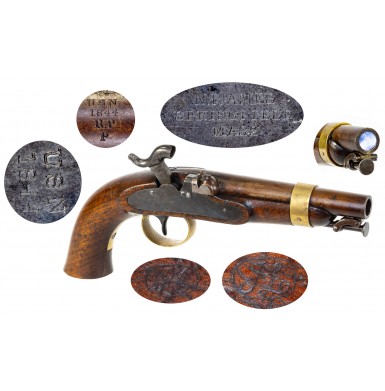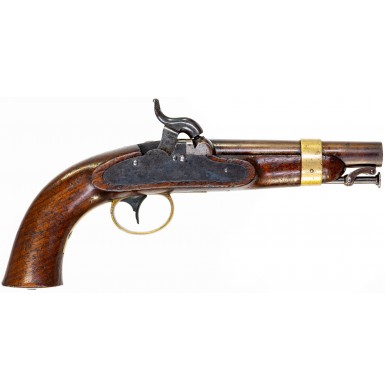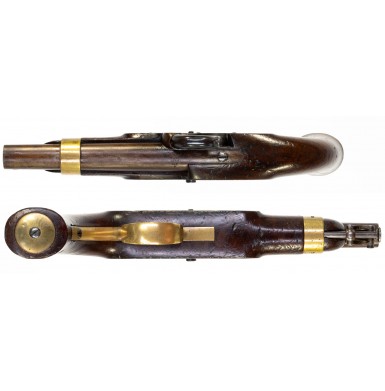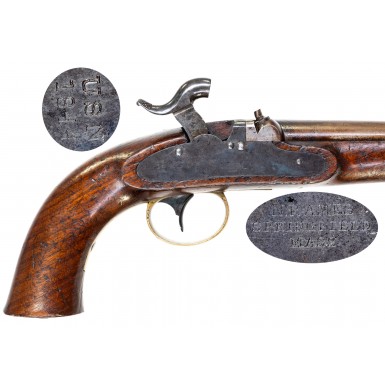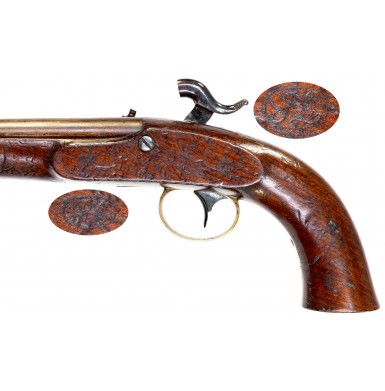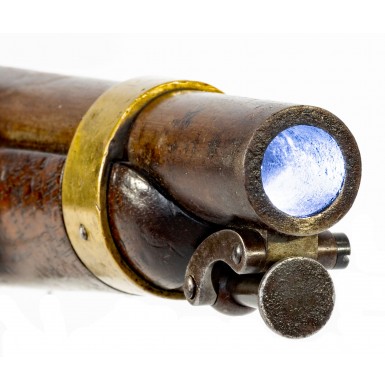Very Nice Ames Model 1842 Box Lock Naval Pistol
- Product Code: FHG-3510-SOLD
- Availability: Out Of Stock
-
$1,895.00
This is an about FINE condition example of a relatively scarce US martial pistol made specifically for the Unites States Navy. The US Model 1842 Naval Pistol has always been a sort of mysterious and somewhat poorly documented pistol. In fact, for many years arms historians labeled it the Model 1843 Naval Pistol, but research has shown that the initial contract for the pistols was dated September 1 of 1842, and there are actually a few extant examples that bear 1842 manufacturing dates, settling that argument once and for all. The Model 1842 is credited with being a revolutionary arm, in that it was the first US military pistol to utilize the percussion ignition system, and even though it was on an extremely limited basis, it was also the first US military pistol to be produced with a rifled bore. In one respect this is not exactly true, as the C.B. Allen produced Elgin Cutlass Pistol pre-dated the arrival of the Model 1842 by about five years, and it used the percussion ignition system as well. However, that pistol was produced in extremely small quantities, with only 150 produced, and most of those were specifically bound for the US Navy’s Wilkes South-Seas Exploration Expedition. Those guns never did not see general issue. This makes them experimental or special purpose at best, allowing the Ames produced Model 1842 pistols to be the first US Naval, or US military, percussion pistols to see general issue.
The overall design profile of the Model 1842 was dramatically different from all pervious and subsequent US military single shot pistols. It is also quite obvious to 19th century military arms students that the pistol is quite similar to the British Model 1842 Naval Pistol from the same period. The coincidence is hardly that, and the heavy British influence on the design has a clear explanation. During the early 1840s, Nathan P. Ames Jr. of the famous Ames Manufacturing Company was commissioned by the US Government to travel to England and Europe and visit the leading arsenals and military arms manufactories of the world. This was a time when most of the European military powers were in the process of transitioning to from flintlocks to the percussion ignition system or were at the very least experimenting with the system. While Ames was in England, he almost certainly visited with George Lovell, the newly appointed Inspector of Small Arms for the British Board of Ordnance. Lovell was in the midst of trying to modernize the small arms of the British military, by adopting the percussion system and updating and improving existing arms patterns. One of his first designs to go into production was the Model 1842 Naval pistol, which was a compact, conventional front action lock percussion single shot pistol with a one-piece walnut stock, brass mountings and a 6” round smooth bore barrel of .56 caliber; the traditional English military “pistol bore”. The stock had a unique flat butt, a dramatic change from the bulbous, rounded, club-butt designs of earlier English and American Naval pistols. The design also incorporated a captive swivel ramrod under the barrel. Clearly this design made an impression on Ames, as the US Model 1842 Naval Pistol was nearly a carbon copy of Lovell’s design.
The other English gun design that was apparently impressive to Ames was Henry Nock’s “Inside Lock” or “Box Lock” design, where the hammer was contained inside the lock plate. This left the exterior of the pistol relatively smooth and snag free and made it much handier to stuff into a waistband, belt, or sash, as seamen often did when boarding an enemy vessel. This allowed the conventional belt hook to be omitted from the design, a feature that had been synonymous sea service pistols since the introduction of handguns to sea going vessels. The US Navy obviously liked what Ames had seen and subsequently designed, and on September 1, 1842, the Navy placed an order with Ames for 3,832 of his newly designed Model 1842 Naval Pistols at the price of $5.00 each. The guns were single shot, percussion smoothbore pistols in .54 caliber with a 6” round barrel, a captive swivel ramrod, a one-piece stock with a flat butt, brass furniture and a flat, Henry Nock inspired “box lock”. The contract specified that the arms were to be delivered over the course of one year, but production difficulties slowed the delivery significantly. Only 300 were delivered in 1842, with an additional 1,700 delivered to the Navy over the next three years. It is believed that Ames only completed some 2,000 of the pistols for the Navy between 1842 and 1845. A small handful of the Ames production specimens, estimated at less than 400, were also purchased by the US Revenue Cutter Service, who were one of the services that was the predecessor to the modern Coast Guard. While the Revenue Cutter Service eventually morphed into today’s Coast Guard, their 18th and 19th century mission was to stop smugglers and collect taxes and tariffs on imported goods.
On 1 July 1845 the US Navy issued a second contract for the Model 1842 Naval Pistols. This contract was for 1,200 guns, and it appears that it was an attempt to obtain the balance of the guns due from the original Ames contract, which was probably reduced from the original 3,832 to 2,000, plus the additional guns that were delivered to the Revenue Service. This second contract was awarded to Henry Deringer of Philadelphia. Deringer purchased all of the machinery to make the pistols from Ames, resulting in a nearly identical product. The primary difference was that rather than bearing Ames markings, these arms bear the markings of Henry Deringer. Three variants of the Deringer lock marking are known, with the first being a small two-line stamp that reads DERINGER / PHILADEL’A. It is believed that this is the same marking stamp used for Deringer’s Model 1817 “Common Rifle” contracts. The second variation carries the same two-line marking, with a large U.S. over it. The third variation has the same two-line lock marking but is also stamped U.S.N. over1847 in two lines, vertically, at the tail of the lock. It is believed that most of the guns produced by Deringer were never delivered to, or at least never accepted by, the US Navy. In general, it is believed that the pistols with the U.S.N. marking on the tail of the lock were acquired by the Navy, and that the ones with the large U.S. were probably acquired by the Navy as well, or possibly the Army. Those with neither the US or USN markings are considered commercial guns that were sold to the general public.
A very small number of extant Deringer contract guns are known today with rifled bores. The bores have the same style of deep, seven-groove rifling found on Deringer’s Common Rifles. It is generally believed that less than 200 of these pistols were produced, and it is likely that less than 40 of them exist today. Those guns are very significant to the history of US martial small arms as they were the first handguns produced for the US military with rifled bores. There is still debate among scholars as to whether these very scarce pistols were acquired by the Navy or purchased by the US Army. In either case it appears that they were strictly experimental to study the effectiveness and suitability of the use of rifled bores in handguns. All known, authentic examples of the rifled Deringer pistols have the lock marking with the large “U.S.” over the Deringer markings, which suggests that these pistols were absolutely acquired for US military service. Establishing the history of these unique pistols is somewhat difficult, as the major texts on the subject of US Naval Small Arms tend to leave this model out. William Gilkerson’s seminal work Boarder’s Away II – Firearms of the Age of Fighting Sail ends with the age of percussion arms, and only mentions the Elgin Naval Cutlass Pistol in passing, with no commentary at all on the Model 1842. Likewise, John McAulay’s definitive work Civil War Small Arms of the US Navy and Marine Corpsstarts in the 1850s, after the Model 1842 was obsolete and the percussion revolver was becoming the standard handgun in Naval service. Frederick Winter’s US Naval Handguns: 1808-1911 is slightly more helpful, but is somewhat dated as well, and Robert Reilly’s United States Martial Small Arms 1816-1865 was helpful as well, although some of Reilly’s information and Winter’s information do contradict each other, making it necessary to interpret what the reality of the situation really is. I hope the foregoing has provided some clarity on the subject of a US Naval pistol that is not well covered in most books on 19th century martial arms but is known as a difficult gun to find in high states of preservation, and even more difficult to find with a rifled bore.
Offered here is an about FINE condition example of the US Model 1842 Naval Pistol by the N.P. Ames Manufacturing Company. The gun is in very nice condition throughout and is 100% complete, correct, and original in every way. The lock of the pistol is clearly marked in three horizontal lines forward of the hammer:
N.P. AMES
SPRINGFIELD
MASS
The tail of the lock is marked in two vertical lines USN over the date 1844. The left rear quadrant of the breech area is marked in four lines with USN ownership marks, a matching 1844 production date, the barrel inspector’s initials and with a proof mark and reads:
USN
1844
RP
P
The initials “RP” are those of civilian arms inspector Richard Paine, who inspected US contract small arms for the US Navy from 1839 through 1848. The bolster and butt cap both bear small R sub-inspector markings, and the counterpane of the stock shows two very good script cartouches. The forward cartouche is the RC of Springfield Arsenal civilian contract small arms inspector Rufus Chandler who spent most of his career inspecting the output of the Ames manufactory circa 1831-1850. The rearmost cartouche is the script JL of US Navy Lieutenant Joseph Lanman who served as the final inspector of US Navy contract arms at the Ames factory during the 1840s. His mark is the US Navy’s equivalent of the final inspection cartouche applied to contract arms by officers of the US Ordnance Department.
The pistol retains some strong traces of its original lacquer browned finish on the barrel, which has thinned and worn away due to service and use. About 30% of the thinned brown remains, leaving a streaky appearance on the barrel, where the thinned finish has blended with a moderately oxidized brown patina that makes the gun appear to retain more finish than it actually does. The metal of the barrel is mostly smooth with some freckled and oxidized surface roughness shot through the remnants of finish and some light to moderate pitting at the breech and at the face of the muzzle of the pistol, as well as on the face of ramrod. The lock has the mottled smoky gray and blue patina of dulled and softened case coloring and still has some nice flashes of brighter blues here and there on the lock. Most sources describe the locks of these pistols as being finished “bright”, but it is clear that this lock was originally color case hardened in brilliant colors and other extant examples of high condition Model 1842 Naval Pistols show that color casehardening was the finish on these locks when the pistols were delivered. The lock is mechanically EXCELLENT and functions crisply and correctly on all positions. The mainspring is quite strong and stiff. The cone (nipple) shows some moderate battering, probably from being played with over the years and allowing the hammer to strike the cone without a cap on it. The bore of the pistol is in VERY GOOD condition. Like all standard production Model 1842 Naval Pistols, the bore is smooth and nominally .54 caliber. The bore is heavily oxidation and shows dark discoloration and evenly distributed light to moderate pitting. The flash pitting around the breech aera and the wear in the bore means there is no doubt that this pistol, even though it is in really very nice condition, saw some real-world use and was fired quite a number of times. As is typical of these smoothbore pistols, the gun was produced without sights. As naval handguns were typically only used in boarding operations of enemy ships, rarely was a pistol shot taken at more than two-or-three-times arm’s length, making sights irrelevant. Additionally, in the hand-to-hand melee on a ship’s deck, there was often little time to take careful aim and point shooting was the rule of the day. As such, only the small number of rifled 1842 Naval Pistols were produced with basic fixed sights. The brass furniture of the pistol is in wonderful condition as well and has a muted golden patina that is very attractive. Interestingly, a small groove has been scribed to the top of the single pinned brass barrel band to create a rudimentary ersatz front sight for the pistol. All of the screws remain in good condition with relatively crisp heads and only a couple of them showing some light slot wear noted. Most of the screws retain some dull traces of their blued finish on their heads as well. The original swivel ramrod is in place on the pistol and functions smoothly and easily. These rammers are often described as being left in the bright when the guns were manufactured, however the examination of a handful of extant very high-grade examples indicates that the rods were partially browned. The exposed portion of the ramrod and the swivels were browned, while the part of the rod stored int eh stock was left in the bight. This example retains strong traces of this brown, which has blended with a moderately oxidized brown patina.
The stock of the pistol is in about FINE condition as well and is relatively nice. It is free of any breaks, cracks, or repairs and has never been sanded. All of the edges remain fairly sharp throughout the pistol and shows no signs of being sanded. Amazingly the stock retains both of the inspection cartouches, the forward one and the reward one. Usually only the rear cartouche remains intact on these pistols, even when they are found in fine condition. As would be expected, the stock does show some numerous scattered handling marks as well as scattered bumps, dings, and mars. However, for any US military single shot pistol, the condition of the stock is really far better than typically encountered.
Overall, this is a really nice condition and attractive example of an relatively scarce US marital single shot pistol. US Naval weapons are always scarce, as they were procured in much smaller numbers than their Army counterparts. A high condition US Model 1842 Naval Pistol by Ames is one of the harder US Naval handguns to find for sale on the market. For any advanced 19th century US martial pistol collector or an advanced US Navy collector, this is a gun that you simply have to have in your collection, and I am sure you will be very happy with this pistol when you receive it.
SOLD
Tags: Very, Nice, Ames, Model, 1842, Box, Lock, Naval, Pistol

